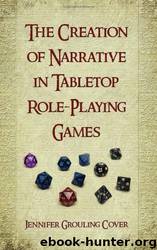Creation of Narrative in Tabletop Role-Playing Games by Jennifer Grouling Cover

Author:Jennifer Grouling Cover
Language: eng
Format: mobi, epub
Tags: Non-fiction
ISBN: 9780786444519
Publisher: McFarland
Published: 2010-01-02T00:00:00+00:00
In her article “Gendered Contexts,” Jenny Cook-Gumperz (1992) studies discourse samples from the make-believe games of two three-yearold girls. Although her main goal is to observe the formation of gender identities rather than the structure of narratives, Cook-Gumperz gives an in-depth model for this format of storytelling and the frames that it involves. She explains that because the children work together to develop a plot, make-believe sessions may be understood as narrative games (CookGumperz, 1992, p. 182); a term that corresponds directly with the way Rilstone (1994) referred to TRPGs as producing narratives and Mackay (2001) defined the RPG as a story-creation system (p. 4). Although adult TRPGs operate on a much more sophisticated level, they do have many similarities with childhood fantasy. The ability to shift frames is one of these similarities. Like D&D, children’s make-believe games rarely involve one act of re-centering to the storyworld but, instead, continually shift between the AW and the APW. Another useful way to look at TRPGs, then, is to compare the frames used in them to those used in make-believe games.
In these make-believe games, Cook-Gumperz (1992) recognizes three distinct voices used by the children: narrative speech, in-character speech, and off-record speech. Narrative speech is used to describe objects and events in the storyworld. In-character speech involves speaking as a character in the make-believe game. Off-record speech is grounded in the actual world and involves organizational planning of the narrative game as well as statements not directly related to the story being told through the game (Cook-Gumperz, 1992, p. 184). Off-record speech includes narrative planning speech, which is used to counter what someone has done or alter the course of events in the story that the children are developing (Cook-Gumperz, 1992, p. 188). These types of speech possess different levels of narrativity, from direct narration in narrative speech to little or no narrativity in off-record speech. I now turn to a linguistic analysis that shows how these forms of talk are nearly analogous to those found in the D&D game.
The Social Frame
The social frame takes place in the here and now of the actual world, rather than the fantasy world. Nevertheless, it can be highly influential on decisions made in the APW. This level consists of two types of speech, offrecord speech and narrative planning speech. Both of these types of speech involve players interacting as players within the social setting of the TRPG.
The bottom level of the model is off-record speech, which contributes the least to the narrative and is often everyday talk rather than part of the narrative. Off-record speech shows the players reacting to the story as an audience by relating events to other cultural texts or making jokes about the actions and characters in the story. It exists in the AW, although it may comment on the textual world and even add to the audience’s understanding of that world. Hendricks (2006) explains that references to popular culture “strengthen the fantasy frame by creating an avenue by which a gamer
Download
Creation of Narrative in Tabletop Role-Playing Games by Jennifer Grouling Cover.epub
This site does not store any files on its server. We only index and link to content provided by other sites. Please contact the content providers to delete copyright contents if any and email us, we'll remove relevant links or contents immediately.
| Battletech | Call of Cthulhu |
| Dungeons & Dragons | GURPS |
| Other Role-Playing Games | Pathfinder |
| Savage Worlds | Shadowrun |
| Strategy | Trading Card Games |
| Traveller | Warhammer |
| World of Darkness |
Arthas: Rise of the Lich King by Christie Golden(2040)
World of Warcraft Chronicle Volume 3 by Blizzard Entertainment(1720)
Pillars of Eternity Guidebook by Obsidian Entertainment(1644)
1628927445Game by Unknown(1538)
The Ultimate Player's Guide to Minecraft by Stephen O'Brien(1508)
Drizzt - 01 - Homeland by R.A. Salvatore(1503)
Dark Elf 02 - Exile by R. A. Salvatore(1464)
Road Games by Road Games(1434)
Playing by the Rules(1407)
Dark Elf Trilogy 01 - Homeland by R.A. Salvatore(1402)
Salvatore 1 - The Crystal Shard by Salvatore R. A(1398)
Starcraft by Blizzard Entertainment(1380)
Binging with Babish by Andrew Rea(1376)
Gaslands by Mike Hutchinson(1320)
The Host by The Host(1315)
The Halfling's Gem by Salvatore R. A(1290)
The Cthulhu Wars by Kenneth Hite(1278)
150 Years of Stats Canada! by Stats Canada(1269)
Slaves to Darkness 03 (The Heart of Chaos) by Warhammer(1247)
